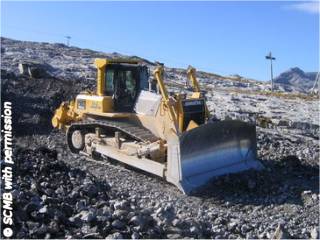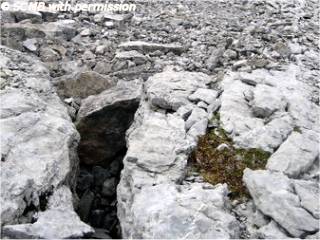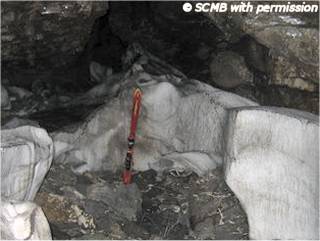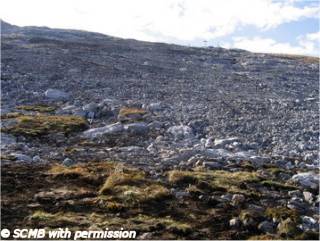Final Solution for Flaine
The French Alpine ski resorts are known for their rugged slopes. Normally these kind of runs need close to a meter of snow in order to be skiable. The high mountain terrain can also be challenging to less than expert skiers. One of the consequences of climate change is that snow depths are thinner, particularly at the start of the season. Snow canons can be used to lay down base but they are costly to run both in terms of water and energy resources.

Durable development?
In order to ski on less snow and to make slopes more accessible resorts have taken to ironing out what they see as the imperfections in their domains and seeding the runs with grass. During the autumn the heavy artillery of snow canons is complemented with Semtex, bulldozers and rock crushing machines.

Lapiaz filled with rubble
Blanketed by winter snow, skiers on a week’s holiday are pretty much oblivious to the changes going on beneath their feet. In fact it is all very comforting that the slopes and snow cover resemble the local snow-dome where they probably learned to ski. Research by resorts such as les Arcs shows that the average holiday skier prefers this type of slope and the consumer is king after all.
Come back in the summer and it all looks very different, the overhead catenary, pylons and cabins that winch skiers to the top of runs are juxtaposed with bright green or rock grey motorways carved through the mountainside. All very unattractive. No-where is this destruction of the natural environment more evident than at Flaine in the Haute-Savoie. In his book, Flaine la création, Eric Boissonnas remembers that “At Flaine, the limestone cliffs cut and encircled the site, we had to bow to the discipline they imposed”. Fine words that have melted away like a summer snow.
Although the Faucigny mountains have a good snow record, they receive the first flakes from any weather fronts heading down from the north of France, the geology at Flaine is not ideal for a ski resort. The “désert de Platé” is the largest limestone plateau in Europe. Over tens of thousands of years the corrosion by mildly acidic rain has created a network of potholes called Lapiaz. This geological wonder is a paradise to cavers but the rugged slopes require considerable snow depth to be skied and off-piste presents the same dangers as glaciated terrain. Serious injuries and deaths to skiers who stray from the marked runs are common.

and the skier?
In September members of Mont-Blanc caving club made a trip to the area to explore some crevasses. The long hot summer had melted a lot of the permanent snow in these fissures and they were hoping to explore deep into the mountain. They were shocked by the level of terraforming going on in the area. The project had begun the previous year on the Faust run. Olivier Lanet told us that the limestone has been excavated to a depth of three meters in places to create a wide and uniform avenue for skiers. The gravel created by the digging has been used to fill in the lapiaz on the edge of the slopes threatening access to some of their favourite subterranean passages. Olivier accused the resort of “gratuitous violence against a mountain that cannot defend itself”. Environmental group Mountain Wilderness sees a serious contradiction for a resort that is aiming for the ISO 14000 certification for environmental management and asks ironically if they are using “bio diesel in the bullzoers and grading machines”.

Hardcore
Flaine is run by the Compagnie des Alpes. The CdA was created by the Caisse des dépôts et consignations, a public finance body, in 1989. During the Vichy regime functionaries from the Caisse des dépôts ran the commercial operations of the Drancy concentration camp north of Paris. Flaine intends to remodel the Lucifer piste next summer. It is nothing personal, just business.
Further Information
Mont-blanc Spelio Club
Flaine - la création, Eric Boissonnas. ISBN: 2910342018
Posted by
davidof on Thursday, 14 December, 2006 at 08:50 PM
An other page about this final solution
http://flaine.courir74.com/
Posted by
serge on Friday, 29 December, 2006 at 07:12 PM
Over the years many valleys have been drowned in hydro development or in leisure concrete, the forests are thinner and sick due to general pollution of the air, expansion of resorts and associated infrastructure often means removal or destruction of local habitats, either way the degradation of the mountain environment is due to human actions. But if we declare that whatever human actions have done to the mountains can equally well be undone - we have a problem. Humans can only save the heritage that comes down to them from previous generations if very many of them want to do so. In order to want to do so they have first to know, then to understand, and then to feel and to feel strongly that the degradation of mountain ecosystems has to stop.
Posted by on Tuesday, 05 June, 2007 at 01:41 PM
Management is the key, ski resorts are business owned by business men, stopping is something that is unlikley to happen in one bold step. Studies are currently being carried out to identify ways that ski resorts can swap some of their worst poluting practices for greener soultions. In adittion they are looking at solutions to exchange ski revenue for other revenue. This is obvioulsy being driven By $ a not a new understanding of the degradation of the mountain ecosystem. Everyone knows we have polution problems, but we need workable soultions. Please also post on Snow ski reports
http://www.totalski.com
Posted by
Snow ski resort on Tuesday, 03 July, 2007 at 02:15 PM
Page 1 of 1 pages
Comments are now closed




